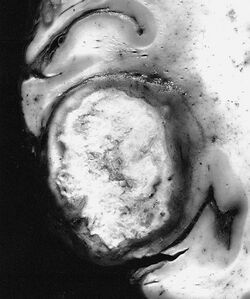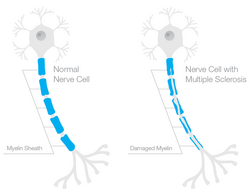Medicine:Nervous system disease
Nervous system diseases, also known as nervous system or neurological disorders, refers to a small class of medical conditions affecting the nervous system. This category encompasses over 600 different conditions, including genetic disorders, infections, cancer, seizure disorders (such as epilepsy), conditions with a cardiovascular origin (such as stroke), congenital and developmental disorders (such as spina bifida), and degenerative disorders (such as multiple sclerosis, Alzheimer's disease, Parkinson's disease, and amyotrophic lateral sclerosis).[1]
Signs and symptoms
Signs and symptoms can vary depending on the condition. Given the significance of the nervous system in human physiology, symptoms can involve other organ systems and result in motor dysfunction, sensory impairment, pain, etc.
Causes
Genetic
Some nervous system diseases are due to genetic mutations.[2] For example, Huntington's disease is an inherited disease characterized by progressive neurodegeneration.[3] Huntington's disease results from a mutation in either copy of the HTT gene, which results in an abnormally folded protein.[4] The accumulation of mutated proteins results in brain damage of the basal ganglia.[4]
Huntington's disease stems from a mutation in either copy of the HTT gene, leading to the production of an abnormally folded protein known as huntingtin. This mutated protein accumulates within the brain, particularly affecting the basal ganglia, a cluster of nuclei deep within the brain critical for motor control and coordination. The accumulation of mutated huntingtin proteins disrupts normal cellular functions, leading to widespread brain damage and neuronal death over time.
The hallmark symptoms of Huntington's disease include involuntary movements, cognitive decline, and psychiatric disturbances, severely impacting an individual's quality of life and functional independence. Due to its genetic basis, Huntington's disease follows an autosomal dominant inheritance pattern, meaning that offspring of affected individuals have a 50% chance of inheriting the mutated gene and developing the disease themselves.
The progressive nature of Huntington's disease underscores the urgent need for effective treatments and interventions to alleviate symptoms and slow disease progression. While current therapies focus on managing symptoms and improving quality of life, ongoing research efforts aim to unravel the underlying mechanisms of the disease and develop targeted therapies to address its root causes. Additionally, genetic testing and counseling play a crucial role in identifying individuals at risk of inheriting Huntington's disease, enabling informed decision-making and early intervention strategies.[5][failed verification]
Congenital/developmental defect
Developing babies can have birth defects that affect the formation of the nervous system.[6] For example, Anencephaly (or spina bifida) causes abnormalities in the nervous system due to neural tube defects.[6]
Anencephaly is a severe congenital disorder characterized by the incomplete development of the brain and skull. In affected individuals, a major portion of the brain, including the forebrain and cerebrum, may be absent or underdeveloped. This condition typically arises during the early stages of embryonic development when the neural tube, which forms the brain and spinal cord, fails to close properly. Anencephaly is a life-limiting condition, and infants born with this disorder often have significant neurological impairments.
Spina bifida is another neural tube defect that occurs during embryonic development. In individuals with spina bifida, there is incomplete closure of the spinal column, leading to the exposure of the spinal cord and its covering membranes. The severity of spina bifida can vary, ranging from mild cases with minimal symptoms to more severe forms that result in significant neurological complications. This condition can affect motor function, sensation, and other aspects of nervous system functioning.
These congenital defects highlight the critical importance of proper neural tube development during early pregnancy. Factors such as genetic predisposition, nutritional deficiencies (especially folic acid), and environmental influences can contribute to the occurrence of these defects. Early detection through prenatal screening and diagnostic tests allows for informed decision-making and the implementation of appropriate medical interventions to manage the condition. Additionally, ongoing research aims to enhance our understanding of the underlying causes of congenital nervous system defects and develop strategies for prevention and treatment.[7][failed verification]
Cancer
Specialized cells in the central nervous system, such as glial cells, may proliferate abnormally and form gliomas.[8] Glioblastoma is an aggressive form of glioma.[9]
Infection
Pathogens like fungi, bacteria, and viruses can affect the nervous system.[10] For example, meningitis is a common infection of the central nervous system, where bacterial or viral infections cause an inflammation of the meninges.[11]
Seizure disorder
It is suspected that seizures occur because of synchronized brain activity.[12] Epilepsy, for example, is characterized by an abnormal electrical activity in the brain, which causes repeated seizures.[13]
Vascular
The brain is rich in blood vessels because it requires a lot of nutrients and oxygen.[14] A stroke may result from a blood clot or hemorrhage.[15]
Degenerative
A neurodegenerative disease is a disease that causes damage to neurons. Examples of neurodegenerative disease include Alzheimer's disease,[16] Parkinson's disease,[17] and amyotrophic lateral sclerosis.[18] For example, multiple sclerosis (MS) is an inflammatory neurodegenerative disease where the body initiate an inflammatory reaction in the central nervous system, and causes damage to neurons.[19][20] Neurodegneration is different in each disease; for example, MS is a result of a degenerative process called demyelination.[19] On the other hand, Parkinson's disease results from damage of neurons in the Substantia Nigra, which is important to initiate motor behavior.[21]
Anatomy
Central nervous system (CNS)
According to Tim Newman, the central nervous system is made up of the brain and spinal cord, it collects information from the entire body and it also controls functions throughout the entire body.[22]
Brain
Newman's research also shows that the brain is the most complex organ in the entire body. The brain is split up into 4 lobes: the temporal, parietal the occipital, and the frontal.The brain has over 100 billion neurons and it uses about 20% of the body's oxygen.[23]
Spinal cord
The spinal cord runs through most of the back. The spinal cord contains a total of 31 spinal nerves in between each vertebra. The nerves connect to the peripheral nervous system.[22]
Peripheral nervous system
The peripheral nervous system connects to the muscles and glands and sends information to the central nervous system.[24]
Diagnosis
There are a number of different tests that can be used to diagnose neurological disorders.
Lumbar puncture
A lumbar puncture (LP), also known as a spinal tap, is a procedure where a hollow needle is inserted into the subarachnoid space of the spinal cord, allowing for the collection of cerebrospinal fluid (CSF) for collection and subsequent analysis. Red and white blood cell counts, protein and glucose levels, and the presence of abnormal cells or pathogens such as bacteria and viruses can all be screened for. The opacity and color of the fluid can also yield useful information that can assist in a diagnosis.
Treatments
The treatments for nervous system disorders varies depending on the condition, and can include interventions such as medication, surgery, and therapy.
See also
- Central nervous system disease
- Peripheral neuropathy
References[25]
- ↑ "Nervous System Diseases – Neurologic Diseases" (in en). MedlinePlus. https://medlineplus.gov/neurologicdiseases.html.
- ↑ Breedlove, S. Mark (2018). Behavioral Neuroscience. New York: Oxford University Press. pp. 364. ISBN 9781605357430.
- ↑ Podvin, Sonia; Reardon, Holly T.; Yin, Katrina; Mosier, Charles; Hook, Vivian (March 2019). "Multiple clinical features of Huntington's disease correlate with mutant HTT gene CAG repeat lengths and neurodegeneration". Journal of Neurology 266 (3): 551–564. doi:10.1007/s00415-018-8940-6. ISSN 0340-5354. PMID 29956026.
- ↑ Jump up to: 4.0 4.1 Breedlove, S. Mark (2018). Behavioral Neuroscience. New York: Oxford University Press. pp. 365. ISBN 9781605357430.
- ↑ McKusick VA. Human genetics. Annu Rev Genet. 1970;4:1-46. doi: 10.1146/annurev.ge.04.120170.000245. PMID: 4950059.
- ↑ Jump up to: 6.0 6.1 Johnson, Candice Y.; Honein, Margaret A.; Flanders, W. Dana; Howards, Penelope P.; Oakley, Godfrey P.; Rasmussen, Sonja A. (2012). "Pregnancy termination following prenatal diagnosis of anencephaly or spina bifida: A systematic review of the literature". Birth Defects Research Part A: Clinical and Molecular Teratology 94 (11): 857–863. doi:10.1002/bdra.23086. ISSN 1542-0760. PMID 23097374.
- ↑ Van Gils J, Magdinier F, Fergelot P, Lacombe D. Rubinstein-Taybi Syndrome: A Model of Epigenetic Disorder. Genes (Basel). 2021 Jun 24;12(7):968. doi: 10.3390/genes12070968. PMID: 34202860; PMCID: PMC8303114.
- ↑ Breedlove, S. Mark (2018). Behavioral Neuroscience. New York: Oxford University Press. pp. 208. ISBN 9781605357430.
- ↑ Lim, Michael; Xia, Yuanxuan; Bettegowda, Chetan; Weller, Michael (July 2018). "Current state of immunotherapy for glioblastoma". Nature Reviews Clinical Oncology 15 (7): 422–442. doi:10.1038/s41571-018-0003-5. ISSN 1759-4774. PMID 29643471.
- ↑ Houlihan, Catherine F.; Bharucha, Tehmina; Breuer, Judith (June 2019). "Advances in molecular diagnostic testing for central nervous system infections". Current Opinion in Infectious Diseases 32 (3): 244–250. doi:10.1097/QCO.0000000000000548. ISSN 0951-7375. PMID 30950854. https://discovery.ucl.ac.uk/id/eprint/10071905/.
- ↑ Breedlove, S. Mark (2018). Behavioral Neuroscience. New York: Oxford University Press. pp. 49. ISBN 9781605357430.
- ↑ Breedlove, S. Mark (2018). Behavioral Neuroscience. New York: Oxford University Press. pp. 89. ISBN 9781605357430.
- ↑ Breedlove, S. Mark (2018). Behavioral Neuroscience. New York: Oxford University Press. pp. 88. ISBN 9781605357430.
- ↑ Breedloe, S. Mark (2018). Behavioral Neuroscience. New York: Oxford University Press. pp. 50. ISBN 9781605357430.
- ↑ Alsharif, S. Mark (2018). Behavioral Neuroscience. New York: Oxford University Publisher. pp. 51. ISBN 9781605357430.
- ↑ Hurtley, Stella M. (1998-11-06). "Neurodegeneration" (in en). Science 282 (5391): 1071. doi:10.1126/science.282.5391.1071. ISSN 0036-8075.
- ↑ Breedlove, S. Mark (2018). Behavioral Neuroscience. New York: Oxford University Press. pp. 361. ISBN 9781605357430.
- ↑ Breedlove, S. Mark (2018). Behavioral Neuroscience. New York: Oxford University Press. pp. 350. ISBN 9781605357430.
- ↑ Jump up to: 19.0 19.1 Shroff, Geeta (2018-02-12). "A review on stem cell therapy for multiple sclerosis: special focus on human embryonic stem cells". Stem Cells and Cloning: Advances and Applications 11: 1–11. doi:10.2147/SCCAA.S135415. ISSN 1178-6957. PMID 29483778.
- ↑ Breedlove, S. Mark (2018). Behavioral Neuroscience. New York: Oxford University Press. pp. 35. ISBN 9781605357430.
- ↑ Breedlove, S. Mark (2018). Behavioral Neuroscience. New York: Oxford University Press. pp. 47. ISBN 9781605357430.
- ↑ Jump up to: 22.0 22.1 "Central nervous system: Structure, function, and diseases" (in en). 22 December 2017. https://www.medicalnewstoday.com/articles/307076.php.
- ↑ "Central nervous system: Structure, function, and diseases". 22 December 2017. https://www.medicalnewstoday.com/articles/307076.php.
- ↑ "Peripheral Nervous System". http://www.indiana.edu/~p1013447/dictionary/perinerv.htm.
- ↑ "Nervous System Side Effects" (in en). 2012-07-02. https://www.cancer.net/coping-with-cancer/physical-emotional-and-social-effects-cancer/managing-physical-side-effects/nervous-system-side-effects.
External links



